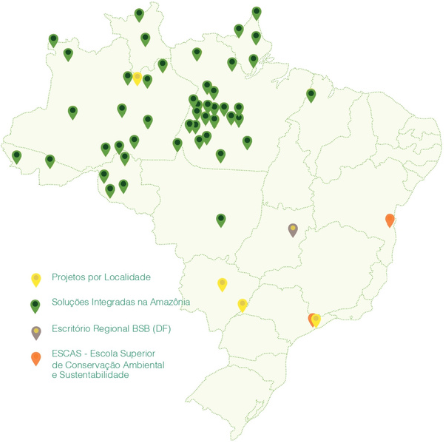We act in Integrated Solutions with society, in the effectiveness of the management of Conservation Units and in partnerships.
LIRA – Integrated Legacy of the Amazon Region: focuses on increasing effectiveness in protected area management, with intensified integrated and networked work.
MPB –
Participatory Biodiversity Monitoring: works on biodiversity monitoring in 18 Conservation Units (12 million hectares) in the Amazon with the contribution of local communities.
MOSUC –
Motivation and Success in the Management of Protected Areas: supports the strengthening of SNUC – National System of Protected Areas, and the mobilization of society. Among the results achieved is the national restructuring of the ICMBio Volunteer Program, with more than 30,000 volunteers enrolled.
NAVEGANDO EDUCAÇÃO EMPREENDEDORA: seeks to strengthen entrepreneurs in the value chains of the Puranga Conquista Sustainable Development Reserve (SDR).
IPÊ is headquartered in Nazaré Paulista, less than 100 kilometers form the city of São Paulo. This municipality is known for its scenic natural beauty and is strategic for the conservation of socio-environmental resources, including water and Atlantic Forest. Nazaré Paulista harbors a portion of the of the Cantareira System reservoirs, which are responsible for providing water to nearly ten percent of the Brazilian population. IPÊ develops conservation research and environmental education projects in the region. The primary themes of these initiatives are: restoration of the Atlantic Forest, conservation of wild mammals, ecosystems services and sustainable business.
Sowing Water: to increase the System’s water security, IPÊ develops the project based on forest restoration actions, sustainable productive systems, as well as environmental education and public policies in eight municipalities that make up the System, five in the state of São Paulo and three in Camanducaia.
We developed initiatives for the conservation of three endangered species (lowland tapir, giant anteater, and the giant anteater
) involving research, environmental education, tourism, and training:
INCAB – National Initiative for Lowland Tapir Conservation: the project, which is over 25 years old, has the largest database of the lowland tapir
(Tapirus terrestris), recognized as the forest gardener.
The
Canastra Armadillo Project: documented the important role of armadillos as ecosystem engineers. The species is now on the list of key mammals to guide the creation of protected areas and conservation corridors in Mato Grosso do Sul.
Pantanal Sustainable Landscapes: identifies paths with potential to strengthen sustainable development in the biome based on sustainable cattle farming, conservation of protected areas, and ecotourism.
Together with communities, rural producers, professionals that work in public agencies, and researchers from other institutions we developed, in 2001, the Map of Dreams with the objective of forming life corridors in Pontal do Paranapanema. Based on the priority actions identified in the Map, we work on landscape management, balancing economic gains with the maintenance of ecosystem services and conservation of endangered species:
Corridors of Life: we have already planted almost 6 million trees, including the largest forest corridor ever restored in the Atlantic Forest.
The photo shows the largest forest corridor ever restored in the Atlantic Forest with 2.4 million trees, which connects Morro do Diabo State Park with the Mico-leão-preto Ecological Station.
Photo Credit: Laurie Hedges
Black Lion Tamarin Conservation Project: one of the longest-running conservation programs – has among its results the change in the species category from “critically endangered” to “endangered”.
Agroforestry Systems: combining food diversity and income generation for rural producers.
Community Nurseries: we have contributed to the training and closely monitored eight nurseries, five of which are led by women.
Environmental Education: adoption of an environmental education program by schools in the city of Teodoro Sampaio (SP), with courses for teachers and students from the public network.
Guaranésia/MG
We implemented a model farm in silvopastoral activity, to promote and accelerate sustainable dairy farming allied to the planting of native species trees.
Nova Iguaçu and Duque de Caxias/RJ
In Baixada Fluminense, we have worked to implement 100 hectares of agroforestry systems in 33 settlements, small farms, and rural communities.
